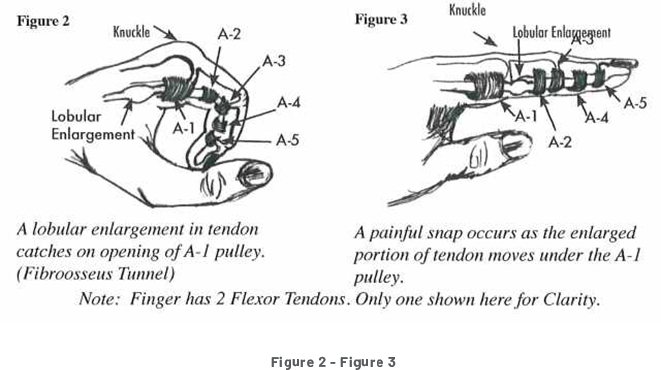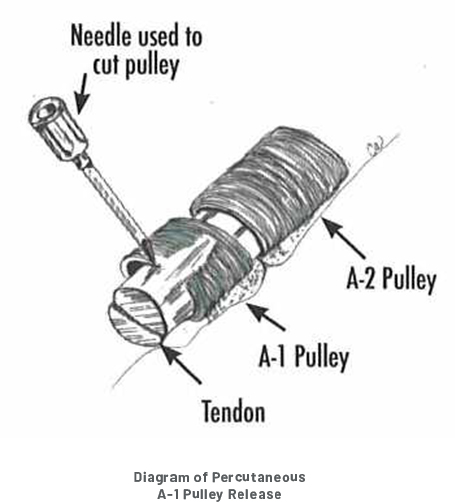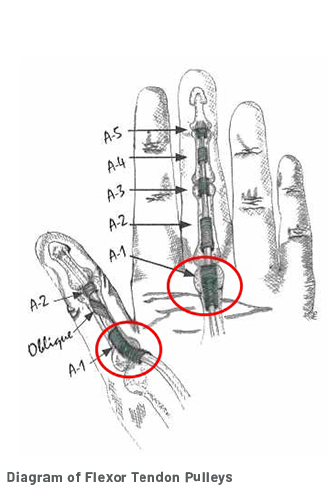Trigger Finger
Trigger digit, also commonly referred to as trigger finger, can range from an irritating condition to a severely hindering one. At Nebraska Hand & Shoulder, we provide solutions for individuals experiencing trigger finger. Our minimally invasive procedure can eliminate the source of the condition and get you back to experiencing life without pain. You can learn more about what causes trigger finger below, or contact us today to schedule an appointment.
Introduction To Trigger Finger
What Are Tendons?
Tendons are the rope-like extension of muscles. They slide in a well-defined channel and attach to a bone to cause joint motion. There are specific sites along the course of a tendon where it is restrained by pulleys to prevent it from "bow stringing."
What Are Pulleys?
Pulleys are tight bands beneath which the flexor tendons must glide. There is a sheath in between the pulley and the tendon itself. This is a very thin, hollow tube constituting a self-lubricating system. The A-1 pulley can be sacrificed in each finger without side effects because there are 4 more to hold the tendon (Figures 1-3).
In fact, only 2 of the 5 in each finger and 2 of the 3 in the thumb are needed for normal function. The thumb has 3 pulleys but only needs 2 for normal motion. The A-1 pulley at the base of the thumb, the metacarpo-phalangeal joint level (MCP), and the A-1 pulley to each of the fingers are overwhelmingly the main location of the problem "trigger finger."

History
Trigger finger was first described in 1850. Tightening (stenosis) of the first extensor compartment of the wrist was described by Felix de Quervain, a Swiss surgeon, in 1895. This problem is almost identical and more painful. These are among the most common pain-causing conditions of the hand in adults aside.

Underlying Cause
Careful evaluation of tissue taken from the pulley at the time of surgery for trigger finger reveals that the cause is cellular change (metaplasia) of the pulley. The tendon sheath narrows due to pulley thickening thus reducing the passage diameter. The narrowing causes localized tendon enlargement. This restricts the gliding of the flexor tendon, resulting in the snapping phenomenon, i.e. triggering (Figure 2 & 3).
It is unclear whether frequency or the force applied to the tendon contributes to development of a trigger finger. It mostly occurs after age 30. Age and genetics seem to play the greatest role in development. Frequent activity of fingers has not been proven to influence the onset.
Symptoms
Discomfort and Tenderness
At the onset, a patient with trigger finger typically experiences localized discomfort in the palm of the hand at the palmar crease (knuckle level). Local tenderness and sometimes a nodule may be felt if the palm is pressed firmly.
Swelling and Stiffness of the Finger
In most patients, the involved finger or thumb feels swollen. Visible swelling, however, is the exception rather than the rule. One of the most common complaints of trigger finger is stiffness in the morning, which must be separated from possible arthritis. As the day wears on, the feeling of stiffness usually resolves.
Pain and Inability to Move
As the condition progresses, it becomes more painful, ultimately resulting in obvious snapping, getting to a point where one may have to manually straighten or bend the snapping finger with the other functioning hand. It can become too painful to move it through its own normal range of motion.
Triggering or Snapping
The most common triggering occurs in the thumb, second most commonly in the long finger. It can occur in all five digits, either simultaneously or one after the other. Actual triggering or snapping occurs due to the size difference between a tendon and its sheath (Figures 2 & 3).
Incidence
Trigger thumb occurs in 1 in 1000 infants. Due to an infant's tendency to clasp his thumb in a fist, congenital triggering is not usually picked up until after the sixth month of life. The majority of patients presenting with trigger finger are in their forties or fifties, and about 19% (1 out of 5) of patients have multiple digit involvement. Most adults with trigger digit have or have had carpal tunnel syndrome.
Treatment
Early Treatment
The duration of symptoms prior to receiving any treatment has been shown to effect the rate of success in treatment. It was once thought that this could be treated within a few weeks of onset with a splint limiting MP joint motion, but splinting is ineffective. The problem is not caused by motion. Early treatment with cortisone injection gives variable results though and some can experience lasting relief. How cortisone helps is unknown.
Late Treatment
If patients have symptoms for more than a few months, or if they have severe triggering, or are diabetic, cortisone injections are less likely to be effective. Minor surgery is often necessary for this group of patients. Patients with marked triggering and multiple involved digits have a higher rate of failure of non-operative treatment in both groups. Treatment for trigger finger with an injection causes some minor discomfort, it is given into a very sensitive area of the hand, however, only one injection is often necessary if it's going to work.
Operative Treatment
Dr. Ichtertz is an expert in A-1 pulley release and performs this procedure on an outpatient basis. There is no blood loss and little risk encountered. Risks include a rare chance of infection, persistent local tenderness, or pain that may be of greater magnitude than the triggering of the finger (extremely rare). With percutaneous A-1 pulley release for trigger thumb, there is a slight chance of nerve injury, thus some may opt for open release of the thumb. Nerve injury with percutaneous finger A-1 release has not been reported.
WARNING MAY CONTAIN GRAPHIC IMAGES


Prognosis
Some trigger digit patients seen go on to recover without the need for surgery. When surgery is undertaken, the prognosis is very good. A very small percentage of patients will continue to complain of local tenderness or pain.
Prognosis for A-1 Pulley Release
Dr. Ichtertz has a very successful track record with percutaneous trigger release. His failure rate is less than 1%. Other surgeons' result reported results to reveal a 6-10% failure rate.
Anderson, Bruce Carl, et al, “Treatment of de Quervain’s tenosynovitis with corticosteroids.” Arthritis and Rheumatism, Vol. 34, No. 7, July 1991, pp. 793-798.
Badalamente, M.A., “Pathobiology of the Human A1 Pulley in Trigger Finger.” The Journal of Hand Surery, Vol. 16A, 1991, pp. 714-721.
Bishop, A.T., “Extensor Triggering in de Quervain’s Stenosing Tenosynovitis.” The Journal of Hand Surgery. Vol. 24A, 1999, pp. 1311-1314.
Dinham, J.M., Meggitt, B.F., “Trigger thumbs in children: a review of the natural history and indications for treatment in 105 patients.” Journal of Bone and Joint Surgery, Vol. 56B, No 1, 1974, pp. 153-155.
Doyle, J.R., Blythe, W.F., “The finger flexor tendon sheath and pulley: anatomy and reconstruction.” AAOS Symposium on Tendon Surgery in the Hand, St. Louis, 1975. The C.B. Mosby Company, pp. 81-87.
Doyle, J.R., “Anatomy of the Flexor Tendon Sheath and Pulleys of the Thumb.”, The Journal of Hand Surgery, Vol. 2, 1977, pp. 149-151.
Eastwood, D.M., Gupta, K.J., Johnson, D.P., “Percutaneous Release of Trigger Finger: An Office Prodedure.” Journal of Hand Surgery, Vol. 17A, 1992, pp. 114-117.
Ezaki, M., “Trigger Finger in Children.”, The Journal of Hand Surgery, Vol. 24A, 1999, pp. 1156-1161.
Fulcher SM, Hill, J.J.; “An Analysis of Patients with Multiple Trigger Digits.” [Poster] 56th Annual Meeting of the American Society for Surgery of the Hand Oct. 4, 2001, Seattle, WA.
Gray, R.G. and Gottlieb, N.L., “Hand flexor tenosynovitis in rheumatoid arthritis: prevalence, distribution, and associated rheumatic features.” Arthritis and Rheumatism, Vol. 20, No. 4, 1970, pp. 103-108.
Griggs, S.M., “Treatment of Trigger Finger in Patients with Diabetes Mellitus.” The Journal of Hand Surgery, Vol. 20, 1995, pp. 787-789.
Harvey, Francis J., et al, “deQuervain’s disease: surgical and non-surgical treatment.” Journal of Hand Surgery, Vol. 15A, No. 1, January 1990, pp. 83-87. (Diagram 4).
Hoffmann, R., “Open Versus Percutaneous Release of the A1-Pulley for Stenosing Tendovaginitis: A Prospective Randomized Trial.”, Techniques in Hand & Upper Extremity Surgery, Vol. 12, 2008, pp. 183-187.
Hollander, J.L., et al, “Hydrocortisone and cortisone injected into arthritic joints, comparative effects of and use of the hydrocortisone as a local anti-arthritic.” JAMA, Vol. 147, 1951, pp. 1629-1635.
Jackson, W.T., et al, “Anatomical variations of the first extensor compartment of the wrist: a clinical and anatomical study.” Journal of Bone and Joint Surgery, Vol. 68A, No. 6, July 1986, pp. 923-926.
Lane, L.B., “Commentary: Percutaneous Release of the First Annular Pulley.” The Journal of Hand Surgery, Vol. 20, 1995, pp. 785-786.
Lapidus, P.W., “Stenosing tenovaginitis.” Surgical Clinics of North America, Vol. 33, 1953, pp. 1317*1347.
Lubahn, J., “Complications of Open Trigger Finger Release.”, The Journal of Hand Surgery, Vol. 35A, 2010, pp. 594-596.
Medl, W.T., “Tendonitis, tenosynovitis, trigger fingers, and deQuervain’s disease.” Orthopaedic Clinic of North America, Vol. 1, No. 2, 1970, pp. 375-382.
Otto, N., Wehby, M., et al, “Steroid injections for tenosynovitis in the hand.” Orthopaedic Review, Vol. 15, No. 5, May 1986.
Patel, M.R., Bassini, L., “Trigger fingers and thumb: when to splint, inject or operate” Journal of Hand Surgery Vol. 17A, No. 1, Jan. 1992, pp. 110-113.
Patel, M.R., “Percutaneous Release of Trigger Digit With and Without Cortisone Injection.” The Journal of Hand Surgery, Vol. 22A, 1997, 150-155.
Peimer, C.A., “Release of the Sixth Dorsal Compartment.” The Journal of Hand Surgery, Vol. 19A, 1994, pp. 599-601.
Pratt, H.L., Bunnell, S., “Use of compound F (hydrocortisone in op) in operative and non-operative conditions of the hand.” Journal of Bone and Joint Surgery, Vol. 35, 1953, pp. 94-102.
Roth, J.H., “Percutaneous A1 Pulley Release: A Cadaveric Study.” The Journal of Hand Surgery, Vol. 20A, 1995, 781-784.
Sampson, S.P., et al, “Pathobiology of human A-1 pulley in trigger finger.” Journal of Hand Surgery, Vol. 16A, 1991, pp. 714-721.
Tanaka, J., “Percutaneous Trigger Finger Release.”, Techniques in Hand and Upper Extremity Surgery, Vol. 3, 1999, pp. 52-57.
Weilby, A., “Trigger finger: incidence in children and adults and the possibility of a predisposition in certain age groups.” Acta Orthopaedics Scandinavia, Vol. 41, 1970, pp. 419-427.
Weiss, A.C., “Treatment of De Quervain’s Disease.” The Journal of Hand Surgery, Vol. 19A, 1994, pp. 595-598.
Witczak, J.W., “Triggering of the Thumb with de Quervain’s Stenosing Tendovaginitis.” The Journal of Hand Surgery, Vol. 15, 1990, pp. 265-268.
Witt,J. “Treatment of de Quervain Tenosynovitis: A Prospective Study of the Results of Injection of Steroids and Immobilization in a Splint.” Journal of Bone & Joint Surgery, Vol. 73, 1991, pp. 219-222
Woods, T.H.E., “deQuervain’s disease: a plea for early operation: a report on 40 cases.” British Journal of Surgery, Vol. 51, No. 5, May 1964, pp. 358-359.



